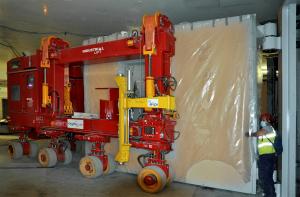Port cells
All 46 doors in place
6 Jul 2020
In ITER, ordinary objects and features often take on an awesome dimension. Take the doors that seal off the port cells around the Tokamak for instance. Doors they are, with hinges that attach them to their frame. But, this being ITER, they are unique: four metres wide and nearly as many in height, they are as thick as a stone wall and as heavy as a small steam locomotive.
The French-German engineering consortium Cegelec/Sommer, subcontractor to the European consortium VFR that is in charge of the construction of the Tokamak Complex, manufactured the nuclear doors and developed a custom-made lifting device dubbed the "moped."
A set of 46 port cell doors will act as confinement barriers, sealing off the port cells that spoke away from the machine and shielding the environment from the radiation generated by the burning plasma. Their thick steel structure (39 tonnes) is filled on site with 7.5 cubic metres (28 tonnes) of high-density, specially formulated concrete that opposes the passage of neutrons and potential contamination.
Installation of the port cell doors in the Tokamak Building began in July 2018 and was completed just a few weeks ago, on 19 June. For close to two years, a bespoke tool dubbed the "moped" (la pétrolette) by the teams handled and manoeuvred the massive structures through the galleries inside the building, shuttling them from the concrete-filling station to their installation location.
A strange yet familiar sight, the bright red moped on yellow wheels will not be seen anymore ...


